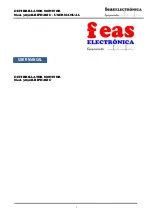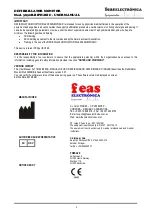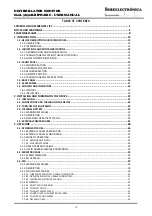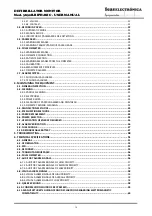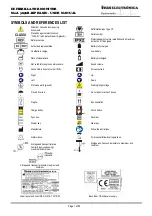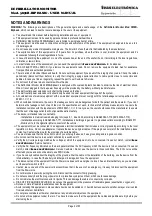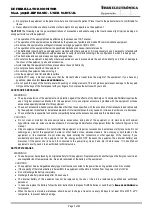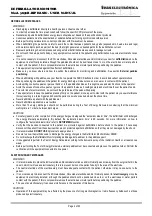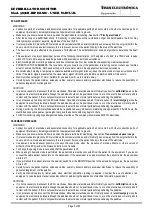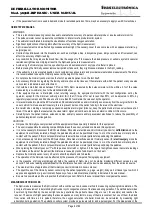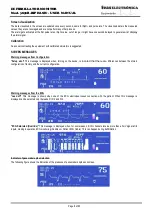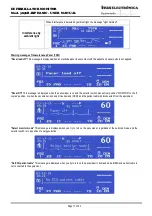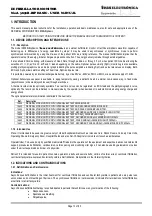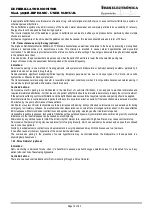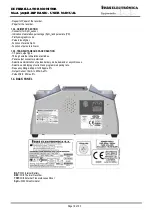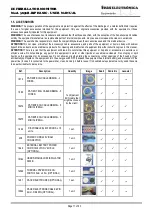
DEFIBRILLATOR MONITOR
Mod. 3850B-BIPHASIC - USER MANUAL
Page 4 of 63
DEFIBRILLATOR MESSAGES
WARNINGS
•
Discharging a defibrillator directly to a healthy person’s chest can be lethal.
•
In order to decrease the time pre-shock should follow the specific CPR protocols of the place.
•
Neonatal and pediatric defibrillation energy levels should be set based on the specific clinical protocols.
•
Conscious patients must be anesthetized or sedated before performing synchronized cardioversion.
•
Before performing cardioversion, correct synchronism with R wave must be assess.
•
When defibrillating the patient be careful to avoid the contact between patient’s body parts (exposed skin, head, arms and legs)
with metallic objects (such as parts of the bed) that might generate non desired paths for the defibrillation current.
•
Rescuers performing chest compressions during external defibrillation are exposed to leakage currents.
•
Do not touch the bed, patient’s body, or any equipment connected to the patient during defibrillation. A severe electrical shock can
result.
•
It is not necessary to disconnect the ECG electrodes, Pacemaker electrodes and/or Oximetry sensor for defibrillation since the
equipment is electrically isolated; although the paddles should not be positioned close to or on the electrodes or metal parts in
contact with the patient, if this is not possible remove the electrodes or metal parts before positioning the paddles.
•
This equipment is protected against the effects of defibrillation.
•
Make sure you know where and how to position the paddles for monitoring and defibrillation. See section External paddles
positioning.
•
When defibrillating with paddles, use your thumbs to operate the SHOCK buttons in order to avoid inadvertent operator shock.
•
When positioning the paddles on the patient for energy discharge, make sure no one is near or in contact with the patient.
•
Avoid spilling conductive paste or gel over hand or in the paddles handles as this might cause and electric shock to the operator.
•
Avoid the excess of conductive paste or gel over the patient’s thorax as it could generate and electric path over the patient’s skin.
•
To avoid risk of electrical shock, do not touch the gelled area of the pads while pacing.
•
Take special care to keep the paddles pressing firmly on the patient, since a poor contact with the patient may cause interference
(noise) resulting in a false trigger and shocks the patient, as well as cause burns at the shock time.
•
Never defibrillate a patient with the paddles wet.
•
Never defibrillate a patient on a wet surface.
•
More than 10 energy discharges should not be performed during the Test of Energy Delivered; considering that the minimum
waiting time is 1 minute, between discharges.
CAUTIONS
•
For safety reasons, after completion of the energy charge and elapsed the “automatic disarm time”, the defibrillator will discharged
the energy internally automatically. By default, the “automatic disarm time” is 60 seconds. For more information on how to
configure the “automatic disarm time” refer to SETUP MENU section.
•
Verify that the devices connected to the patient are protected against defibrillation before shock to the patient. If necessary
disconnect the patient from those devices that are not protected against defibrillation so that they are not damaged by the shock.
•
It is recommended DO NOT USE Xylocaine to apply a shock.
•
Be sure to know the methods used to discharge the energy charged in the Defibrillator Monitor Model 3850B.
•
Do not discharge the Defibrillator Monitor placing paddle against paddle or in the paddle support.
•
It is suggested to perform the Test of Energy Delivered according to the domestic policy of the Institution Health or at least once a
week.
•
Before performing the Test of Energy Delivered, external paddles must be connected and place on the paddles holder. Perform the
verification with the equipment connected to line power.
ELECTROSURGERY MESSAGES
WARNINGS
•
It is recommended to place the ECG electrodes, Pacemaker electrodes and/or Oximetry sensor away from the surgical field in the
case in which it will use an electrocautery; this is to prevent burns on the patient’s body in the area of the electrode.
•
The neutral electrode of the electrocautery must have adequate contact with the patient, otherwise it may cause burns to the
patient.
•
It is not necessary to disconnect the ECG electrodes, Pacemaker electrodes and/or Oximetry sensor for electrosurgery since the
equipment is electrically isolated; although the paddles should not be positioned close to or on the electrodes or metal parts in
contact with the patient, if this is not possible remove the electrodes or metal parts before positioning the paddles.
•
The use of an electrocautery it can cause interference in the operation of this device.
CAUTIONS
•
Operation of this equipment may be affected by the presence of strong electromagnetic or radio frequency fields such as those
produced by electrocautery.



